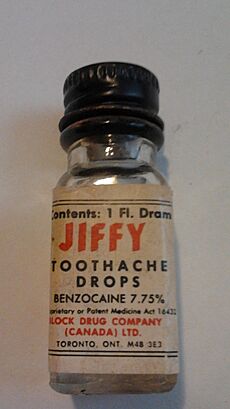Benzocaine facts for kids
Benzocaine is a type of medicine called a local anesthetic. This means it helps to numb a specific area of your body. It's often used as a painkiller to stop pain on the skin or inside the mouth. You might find it in cough drops or in creams and gels for oral ulcers (mouth sores).
Benzocaine is sold under many brand names, like Orajel. It was first made in Germany in 1890 and approved for medical use in 1902.
It's important to know that in the US, products with benzocaine for mouth use should not be given to children younger than two years old. In Europe, this rule applies to children under 12 years old.
Contents
What Benzocaine Is Used For
Benzocaine is used to help with different kinds of pain. It can be used for:
- Numbing the mouth and throat (for sore throats, cold sores, mouth ulcers, toothaches, sore gums, or irritation from dentures).
- Ear pain (earaches).
- Numbing an area before a small surgery or procedure.
- Relieving skin pain from sunburn, ingrown toenails, or hemorrhoids.
Benzocaine in Combination Medicines
Benzocaine is also mixed with other ingredients in some medicines. Here are a few examples:
- Antipyrine-benzocaine otic is a mix of antipyrine and benzocaine. It's used to ease ear pain and help remove earwax.
- Cepacol contains menthol and benzocaine. This is used to treat sore throats.
- A mix of benzocaine and menthol is sold to treat stings and bites from things like bee stings, mosquito bites, and jellyfish stings.
Other Ways Benzocaine Is Used
Benzocaine is a key part of many other products:
- Some ear drops that help remove extra earwax or treat ear problems like otitis media (middle ear infection) and swimmer's ear.
- Special patches with benzocaine have been used to lessen pain from orthodontics (like braces).
- In some countries, it's mixed with menthol and zinc oxide in a liquid powder. This is often used after mosquito bites to soothe the skin.
How You Can Get Benzocaine
Benzocaine comes in many forms:
- For the mouth:
* Lozenges (like Cepacol). * Throat sprays (like Ultra Chloraseptic).
- For the skin:
* Aerosol sprays. * Gels (like Orajel). * Pastes. * Creams (like Lanacane).
- For the ears:
* Solutions.
Important Side Effects
When used correctly on the skin, benzocaine is usually safe and doesn't cause many problems.
However, using too much of it, or using strong products on the skin, can cause serious side effects. These can include seizures, coma, irregular heartbeats, or trouble breathing.
Using too much mouth-numbing medicine like benzocaine can also be risky. It can relax your gag reflex, which helps stop food or liquid from going down the wrong pipe. If this reflex is too relaxed, it's easier for things from your stomach or mouth to get into your lungs. This is especially risky if you use it and then drink liquids before bed.
Using stronger benzocaine products (10–20%) on the mouth or other moist body parts can sometimes lead to a condition called methemoglobinemia. This is a serious problem where your blood can't carry enough oxygen. It's most common in children under two years old. Because of this, health authorities say benzocaine products should not be used in children under two, unless a doctor tells you to and supervises it. In Europe, this warning applies to children under 12. Symptoms of methemoglobinemia can appear quickly, within minutes or hours, after using benzocaine, even the first time.
Benzocaine can also cause allergic reactions, such as:
- Contact dermatitis (red, itchy skin).
- Anaphylaxis (a very rare, severe allergic reaction).
How Benzocaine Works
Pain happens when special nerve endings in your body are stimulated. When these nerves are activated, a signal travels along them to your brain, which then feels the pain.
Benzocaine works by blocking tiny "doors" on these nerve cells called sodium channels. When these doors are blocked, the pain signal can't travel along the nerve to your brain. This stops you from feeling the pain in that area.
The Chemistry of Benzocaine
Benzocaine is a chemical compound. It's made from a substance called p-aminobenzoic acid (PABA) and ethanol. It doesn't dissolve very well in water, but it dissolves much better in alcohol and some other liquids.
History of Benzocaine
Benzocaine was first created in 1890 by a German chemist named Eduard Ritsert. It was introduced to the market in 1902 and was first called "Anästhesin."
Benzocaine in Animal Care
Benzocaine solutions are often used to put amphibians (like frogs) to sleep for surgery. These anesthetics are very strong and work well for numbing amphibians.


